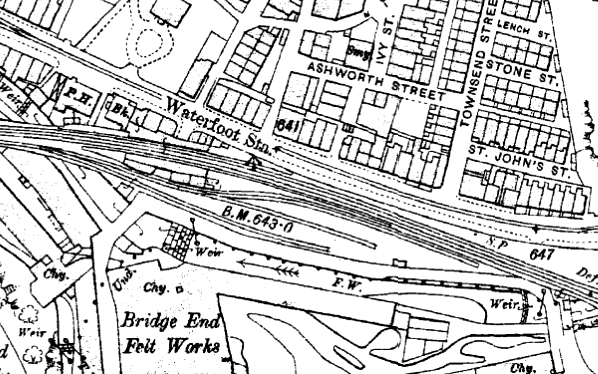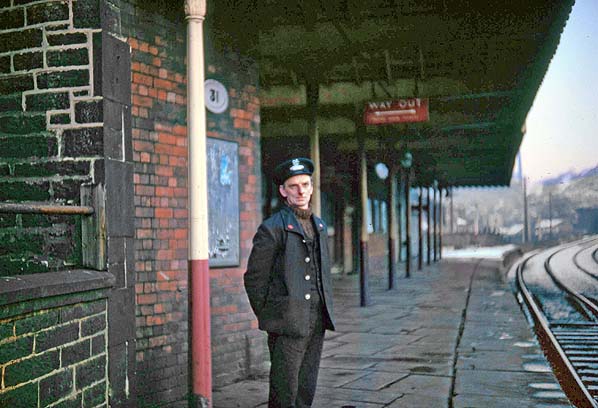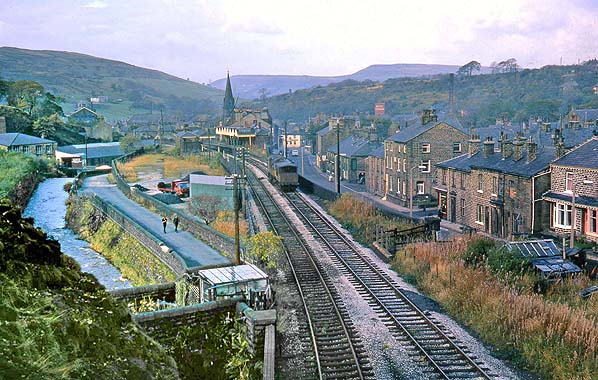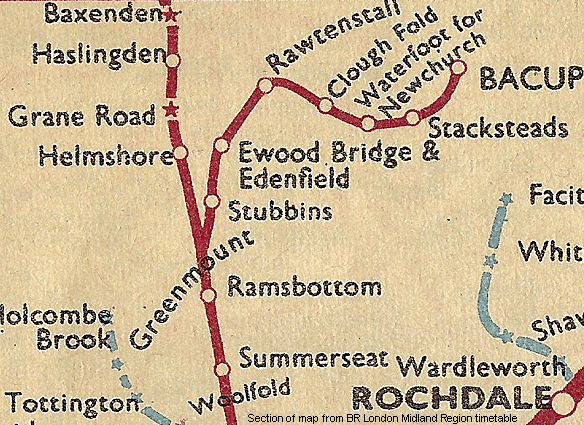Notes: Waterfoot Station was located on the East Lancashire Railways (ELR) Stubbins Junction to Bacup line. The line had opened in stages between 1846 and 1852, the section between Rawtenstall and Bacup being authorised on 27th July 1846.
Waterfoot is located in the Rossendale valley. Rossendale is a deep, narrow valley in the Lancashire Pennines. Encouraged by the construction of the Haslingden to Bacup turnpike road in 1826-8 the five miles between Bacup and Rawtenstall, along the headwaters of the River Irwell, became packed with terraced housing and mills, wherever the valley was wide enough or the slopes gentle enough to accommodate them. Because of the west-to-east alignment and steep slopes, the valley floor of Rossendale is permanently in shadow in late autumn and winter, and this is particularly noticeable in the gorge at Thrutch, where there was simply no space for housing and industry. As elsewhere in the Lancashire Pennines, textile mills lined the swift-flowing river, but Rossendale developed a curious industrial economy with woollen as well as cotton mills, and a particular speciality in manufacturing felt and (from the 1870s) carpet slippers.
Centred at Waterfoot and Newchurch the slipper industry was an offshoot of wool and felt manufacture, and of the custom of millworkers to wrap waste felt around their clogs. To this day the footwear outlets in Rossendale are reminders of slipper manufacture which, like so much of the Lancashire textile industry, has largely moved to overseas where labour is cheaper. In the 1840s the expanding industry and population of Rossendale promised to reward any railway company that could serve this valley, and once a railway had reached Bacup it enabled the local economy to prosper well into the 20th century.
Waterfoot Station opened as Newchurch on 27th March 1848. At the time of opening Newchurch Station was the northern terminus of the route, but the line itself continued for a short distance before coming to an end at the base of a formidable hill known as ‘The Thrutch’.
The line was single-track so the station was provided with only one platform on the north side of the line, to the south of the Rawtenstall to Bacup Road. Train services ran from Newchurch to Manchester Victoria via Clifton Junction.
 |
The terminus status of Newchurch was only a temporary measure. The Thrutch, a short distance east of the station, was a major engineering obstacle that required the building of a tunnel, and work began on 29th September 1851. The contract to build it, and the extension of the line to Bacup, was awarded to Dickson & Mackenzie for £27,845. Two single-track |
tunnels, Newchurch Number 1 and Newchurch Number 2, were constructed to carry the single-track line through the hill. By October 1852 the line was completed through to Bacup, so Newchurch became a through station..
In 1857 Newchurch station was re-sited a little further to the east. The new facilities included a two-storey brick building situated on the Rawtenstall Cowpe Road on the north side of the line. The main entrance for passengers faced onto the road. A stairway led up to a single platform above street level as the line was on an embankment. At platform level the building was |
 |
single-storey, and it was provided with a canopy. Although the line was single-track, and the station had only one platform, two lines actually passed through it. One was a run-round loop that also gave access to a goods yard which was located on the south side of the line, a little to the east of the station. The goods yard on the up side of the line opposite the station was provided with three sidings, a large goods shed and a 10-ton crane.
 On 13th May 1859 the Lancashire & Yorkshire Railway (LYR) absorbed the ELR, and by the 1870s traffic had reached such a level that the LYR decided to double the line between Rawtenstall and Bacup. Authorisation for the works was given on 24th July 1876. At Newchurch a new single-bore tunnel had to be built alongside the existing Number 1 and 2 tunnels. Known as Newchurch Number 3 tunnel it proved difficult to construct, but finally opened to traffic on 17th March 1881. On 13th May 1859 the Lancashire & Yorkshire Railway (LYR) absorbed the ELR, and by the 1870s traffic had reached such a level that the LYR decided to double the line between Rawtenstall and Bacup. Authorisation for the works was given on 24th July 1876. At Newchurch a new single-bore tunnel had to be built alongside the existing Number 1 and 2 tunnels. Known as Newchurch Number 3 tunnel it proved difficult to construct, but finally opened to traffic on 17th March 1881.
At Newchurch an extra platform was required to serve southbound (Manchester) trains, and a single-storey brick building with a canopy was constructed. A subway provided a link between the platforms. To accommodate the new platform and its building the goods shed was demolished, and the goods yard was reorganised. More substantial goods facilities were built west of the station.
In a trade directory of 1828 no mention had been made of Waterfoot, as it was merely part of Newchurch. Official use of the name probably began with the opening of Waterfoot post office in 1851, followed by the creation of the parish of St James, Waterfoot in 1866. It was not until 1st August 1881 that the L&Y Railway recognised the validity of the name, and the station was renamed Waterfoot for Newchurch.
From 1st September 1879 passenger services to and from Manchester were transferred, south of Bury, from the route via Clifton Junction to a new line via Prestwich. In 1888 a tramway opened parallel to the Rawtenstall to Bacup line. It was operated by the Rossendale Valley Tramway company and ran right by Waterfoot station. The steam trams were not as fast as the LYR trains, but they did stop at more places, thereby taking custom away from the railway. In 1909 the tramway was electrified, accelerating the services. To compete with the trams, in 1914 the LYR introduced a ‘Rail-motor’ service – known affectionately as ‘Little Billie’ - between Ramsbottom and Bacup; this called at all stations, including Waterfoot, and supplemented trains that ran through to Manchester.
 |
From 11th April 1916 through passenger services to Manchester were diverted once more, this time to travel via Heywood, adding a considerable mileage to their journeys. The reason for the change was that from this date electric services began on the Bury to Manchester (via Prestwich) line. Passengers for Manchester from Waterfoot were encouraged to |
change onto the electric trains at Bury for a quicker onward journey, and most of them did so. Within a few years many southbound services terminated at Bury Bolton Street.
On 1st January 1922 Waterfoot for Newchurch station became part of the London & North Western Railway (LNWR) when that company absorbed the LYR. However only one year later, on 1st January 1923, the LNWR became part of the London Midland & Scottish Railway (LMS). By summer 1932 the station had thirty services travelling northbound to Bacup on |
 |
weekdays. The first service which had originated from Ramsbottom left at 6:26 am. The last service which had originated from Bury Bolton Street left Waterfoot for Bacup at 11:48 pm. Of the thirty services most trains had started from Bury Bolton Street or from Manchester Victoria, but one train had commenced its journey from Bury Knowsley Street and one from Bolton. Some services had started from Ramsbottom, and two trains started from Rawtenstall. On Tuesday and Fridays only there was an additional service to Bacup at 5:51 pm which originated at Ramsbottom.
In the southbound direction there were twenty-eight weekday departures, the first being for Middleton Junction at 05:26 am. The last train was for Bury Bolton Street and it left Waterfoot at 10:18pm. The rest of the services tended to travel either to Manchester Victoria or Bury Bolton Street, but there were trains at 09:06am, 10:26am and 3:01pm which went to Bury Knowsley Street, as well as shorter workings to Ramsbottom. There were also two services from Waterfoot that terminated at Rawtenstall.
On 1st January 1948 Waterfoot became part of the nationalised British Railways (London Midland Region). In 1954 the line between Bury and Bacup was considered busy enough to warrant the introduction of modern rolling stock, and it was reported in the local press that new diesel multiple units (DMUs) were to be introduced; they entered service on the line in February 1956. Waterfoot had thirty-five trains in each direction, giving a half-hourly service: the most intensive that the line would see
 |
The purpose ofThe Reshaping of British Railways(Beeching Report) of March 1963 was to create an economically viable network, involving the closure of many loss-making passenger lines and stations. The report’s proposals for Lancashire and north Manchester were astonishing. The entire route from Manchester via Bury Bolton Street to Bacup and |
Accrington was earmarked for closure, yet the nearby Manchester – Oldham – Rochdale and the Bolton – Bury Knowsley Street – Rochdale lines were not. The absurdity of withdrawing passenger services on the heavily used, electrified service between Manchester and Bury was acknowledged when, on 8th February 1965, the Minister of Transport refused consent to closure. However goods facilities were withdrawn on 2nd May 1966 and on 14th September 1966 the Minister gave permission for the Rawtenstall to Bacup and Bury to Accrington lines to close, which they did on 5th December 1966. The final passenger train left Waterfoot for Newchurch on Saturday 3rd December 1966. Goods services continued to pass through the station for a short period up to 1968 after which the line closed completely. By February 1969 the track at Waterfoot had been lifted.
The two storey street level entrance building on Bacup road survived into the early 1970s but in 1976 nothing remained of the buildings at Waterfoot station although part of the down platform lingered until at least 1988. By the beginning of the 21st century the removal of the embankment erased all traces of the passenger station. The goods yard site and sections of retaining wall can still be seen today, along with the Newchurch Tunnels entrances which are heavily obscured by vegetation. These are the only reminders that there was ever a railway here.
Tickets from Michael Stewart , route map drawn by Alan Young
Other web sites: www.bacuptimes.co.uk, includes further history and pictures of the Bacup line.
Click here to see of film of a train journey between Bury and Bacup in 1966
See also the Ramsbottom Model Railway Club web site which features 106 old photographs of the East Lancashire Railway and photographs of the clubs excellent layout of Ramsbottom & Stubbins.
Sources:
To see other stations on the East Lancashire Railway Clifton Junction - Bacup line click on the station name on the station name: Clifton Junction, Molyneux Brow, Ringley Road, Radcliffe Bridge, Withens Lane, Bury Bolton Street, Summerseat, Ramsbottom, Stubbins, Irwell Vale (new station on the ELR), Ewood Bridge & Edenfield, Rawtenstall, Clough Fold, Stacksteads & Bacup
See also Stubbins Junction to Accrington:
Helmshore, Haslingden, Baxenden & Accrington |

old7.jpg)


old6.jpg)
old4.jpg)

old8.jpg)

old11.jpg)
8.jpg)
7.jpg)
4.jpg)



 On 13th May 1859 the Lancashire & Yorkshire Railway (LYR) absorbed the ELR, and by the 1870s traffic had reached such a level that the LYR decided to double the line between Rawtenstall and Bacup. Authorisation for the works was given on 24th July 1876. At Newchurch a new single-bore tunnel had to be built alongside the existing Number 1 and 2 tunnels. Known as Newchurch Number 3 tunnel it proved difficult to construct, but finally opened to traffic on 17th March 1881.
On 13th May 1859 the Lancashire & Yorkshire Railway (LYR) absorbed the ELR, and by the 1870s traffic had reached such a level that the LYR decided to double the line between Rawtenstall and Bacup. Authorisation for the works was given on 24th July 1876. At Newchurch a new single-bore tunnel had to be built alongside the existing Number 1 and 2 tunnels. Known as Newchurch Number 3 tunnel it proved difficult to construct, but finally opened to traffic on 17th March 1881. 




6.jpg)

 Home Page
Home Page